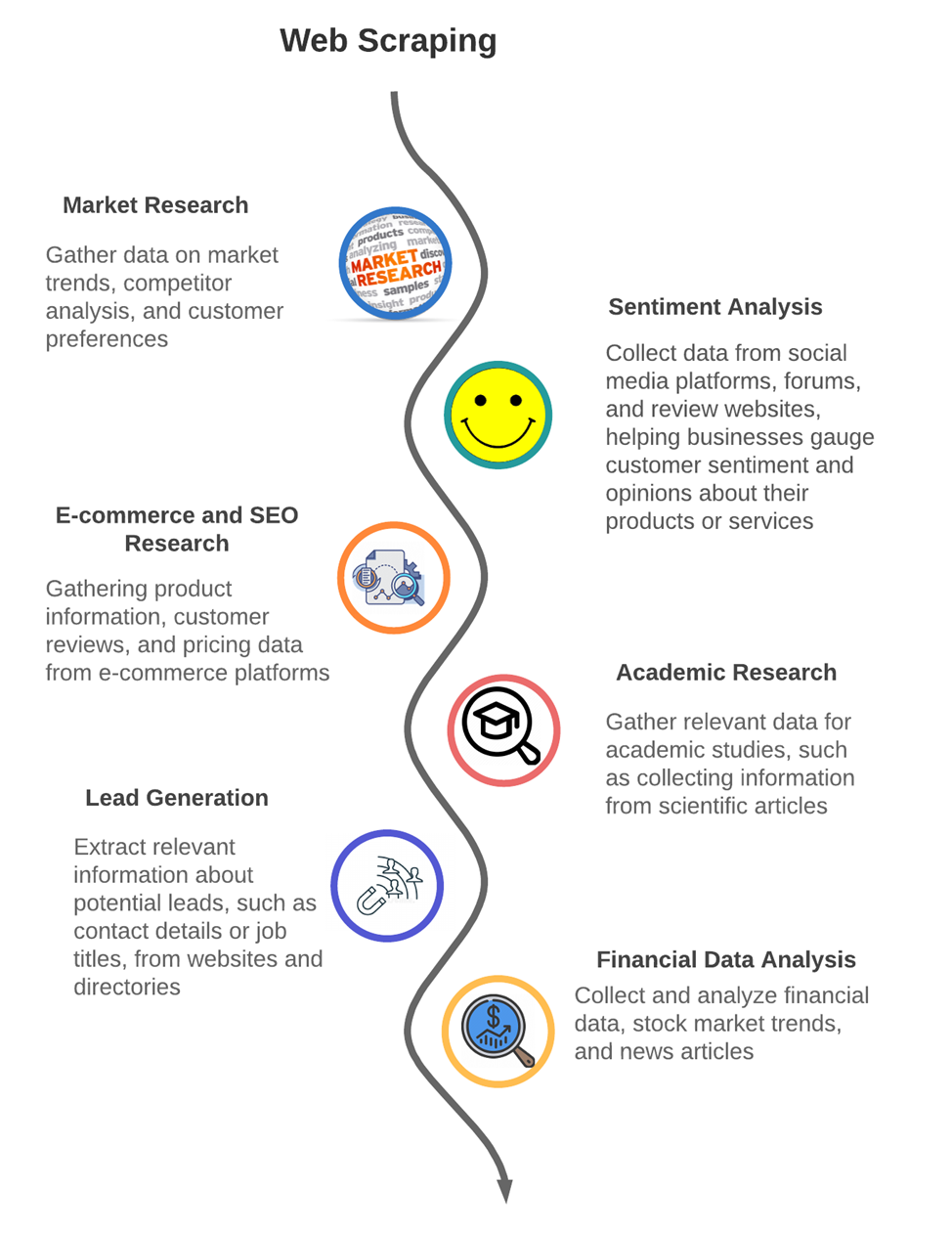Working with data is an essential part of any business, company or research. Data science helps us collect, organize and analyze data to make informed conclusions. It has become its own field of study in recent years, and two main areas within this are scraping and mining. Scraping involves extracting raw data from websites or other sources, while mining involves digging deeper into the already existing datasets to uncover valuable insights that can be used for decision-making purposes.
Web Scraping
Web scraping is the process of data collection from web pages. It involves gathering useful information, structuring it, and saving it in a more convenient format. This could include taking text from a website or downloading images from online sources.
In addition, web scraping is used wherever necessary to constantly collect data from web pages, structure it, and deal with its cleaning.
Techniques and tools used for web scraping
Many different techniques for web scraping allow you to collect whatever type of content you need - whether that's HTML code, product listings, or even entire databases.
When it comes to web scraping, there are three main approaches one can take:
- Using off-the-shelf tools – web scrapers.
- Writing your own code.
- Using an API (Application Programming Interface).
Off-the-shelf web scraping tools are convenient but expensive, while coding provides more flexibility but requires technical skills and knowledge of programming languages such as Python. Web scraping APIs represent a middle ground where the service provider handles complex tasks, and you can focus on processing the extracted data for whatever purpose you have in mind.
Ultimately, which option works best depends on both your project goals and your individual capabilities. If you have solid coding experience, writing your own scraper might work better than relying on off-the-shelf options. But, the less experienced might consider our no-code scrapers or tutorials on how best to use the web scraping API.
Common use cases of web scraping
Scraping is used in all areas where it is necessary to be constantly engaged in the collection of relevant information.

However, there are areas in which web scraping is used more frequently:
- Market research
- Lead generation
- Price monitoring and comparison
- Sentiment analysis
- E-commerce and SEO research
- Financial data analysis
- Academic research
Data plays a critical role in many industries and is the basis for informed decision-making. Without access to relevant and up-to-date information, companies struggle to create compelling propositions and miss opportunities to understand the changing landscape of their industry and competitors.
Benefits and advantages of web scraping
Web scraping allows companies to gather data on competitors, market trends, pricing information, and customer feedback. This information can help identify opportunities, make informed business decisions and remain competitive.
Web scraping is also great for extracting contact information (such as email addresses, phone numbers, and social media profiles) from websites, Google Maps, directories, and social platforms.
Through scraping, companies can successfully search for target companies, adjust their pricing strategies, identify market trends, and provide competitive offers to their customers.
Challenges and limitations of web scraping
However, web scraping has its share of limitations, including technical aspects. Many websites have measures to limit or prevent bot activity, which creates problems for web scraping ventures.
One common security measure is CAPTCHA, which most people are familiar with. It is designed to distinguish between human users and automated programs. In addition, websites can block IP addresses if they detect excessive requests from a particular source.
Some sites use dynamic pages that generate portions of their code to frighten off bots further. Google's search engine is an example. These dynamic elements make scraping automation difficult.
Fortunately, various methods can overcome these limitations and successfully extract data.
Data Mining
Data mining is a powerful process for extracting valuable insights and knowledge from large data sets. It involves the careful processing and analysis of information, allowing researchers and analysts to identify data patterns, relationships and trends.
One key difference between data mining and data scraping is that data mining focuses primarily on analyzing available data rather than collecting it. Data mining works with existing data sets to draw meaningful conclusions and make informed decisions. Unlike data scraping, which involves collecting data from various sources, mining deepens into existing data to extract valuable insights.
Techniques and algorithms used for data mining
For data mining, you have two main options. The first option is to use existing tools specifically designed for data mining tasks. These tools are a ready-to-use solution with several features and algorithms that you can use to solve your data mining problems. They usually have a user-friendly interface that makes data handling and analysis easier.
You can create your own data analysis tool if you have more complex requirements or prefer a customized approach. This involves using machine learning techniques and programming languages such as Python or R to develop a customized solution to your needs. This approach provides flexibility and control over the entire data mining process, allowing you to develop algorithms and workflows to meet your unique goals.
Ultimately, the choice between using off-the-shelf tools or building your own tool depends on factors such as your skill level, the complexity of your data retrieval tasks, and the specific requirements of your project. Both options have advantages and should be based on what best suits your circumstances.
Common applications and industries where data mining is used
Data mining is widely used in various industries and activities, offering many practical applications.

Let's look at some of its most common and valuable data mining applications:
- Understanding and identifying knowledge
- Decision-making and strategy development
- Predictive analytics
- Improving efficiency and productivity
- Personalization and customer segmentation
- Research and discovery
- Data visualization.
By harnessing the power of data, companies and data scientists can gain valuable insights and improve their performance in various areas, such as business intelligence or big data research.
Benefits and advantages of data mining
Data mining helps uncover hidden insights and valuable knowledge from large amounts of data. With data mining, organizations can make data-driven decisions and develop effective strategies. This allows them to optimize operations, improve processes and achieve better results.
By analyzing patterns and trends, companies can expect customer behavior, make market trends forecasting, good marketing campaigns, and make accurate predictions. Using data mining techniques and tools, organizations can optimize data processing, identify patterns more effectively, and decide faster. This leads to increased efficiency, productivity, and cost savings.
Challenges and limitations of data mining
Data mining can be a complex and difficult process with its own set of challenges. First, data mining cannot determine the accuracy or correctness of the data being analyzed. This means that if incorrect or faulty data is used for analysis, it will lead to inaccurate conclusions. It is very important to be careful and ensure that the data provided for analysis is reliable and accurate.
Second, you must avoid analyzing data that has not been pre-processed. Analyzing such unstructured data can make it impossible to get reliable results or meaningful conclusions. Preprocessing includes tasks such as structuring, processing missing values, and dealing with incorrectly recorded data and typos, which are critical to ensure the accuracy and reliability of the analysis.
To overcome these challenges, it is important to prioritize data quality, verify its accuracy, and perform the preprocessing steps. By doing so, it is possible to improve the reliability of the data mining process and make informed decisions based on reliable information.
Web Scraping vs. Data Mining Comparison
Now that we have looked at web scraping and data mining separately, let's compare and contrast the two processes. They are two well-supported methods that are often used in tandem.
Web scraping and data mining work hand in hand to extract and analyze data from different sources. Web scraping allows us to collect data from target websites and other online platforms, and data mining helps us identify patterns, relationships, and valuable insights in the collected data.
Purpose and focus of each method
Both processes are vital and serve different purposes. Web scraping allows us to collect data effectively, while data mining helps us discover hidden patterns and valuable insights in the collected data.
So instead of viewing web scraping and data mining as opposing methods, it is more accurate to consider them complementary tools in a data analysis toolkit. Together, they allow us to collect, refine, and extract valuable insights from the vast sea of information available on the Internet.
Data sources and types of data collected
Web scraping allows you to work with raw data in its original form. Whether dealing with an HTML page or a list, web scraping allows you to collect this data efficiently. Once the data is collected, the next step is parsing it. Parsing involves organizing and structuring the data into a suitable format (for example, an Excel table) for further use.
Data mining focuses on working with pre-structured data. This data is already organized and stored as tables, databases, or datasets. Unlike web scraping, data mining does not involve collecting or preparing raw data.
Techniques and tools utilized
As mentioned, web scraping and data mining use different techniques and tools. Tools that are great for web scraping may not be great for data mining, and vice versa.
Web scraping requires specialized tools to extract data from websites and other online sources efficiently. These tools have features such as parsing HTML, processing HTTP requests, and extracting content.
On the other hand, data mining tools are specifically designed to analyze structured data such as databases, datasets, or tables. These tools focus on processing and exploring existing data sets, using algorithms and statistical methods to identify patterns, relationships, and insights.
Choosing the right tools for each task is crucial to ensure optimal performance and successful web scraping and data mining results.
Data preprocessing and cleaning processes
When it comes to data cleaning and preparation, these tasks are usually performed during the data scraping phase. This includes removing irrelevant or noisy data, processing missing values, correcting inconsistencies and ensuring data consistency.
On the other hand, the data mining phase involves further processing and analysis of the prepared data. Data mining techniques such as clustering, classification, association search, or prediction are used to identify meaningful relationships and trends and make informed decisions based on the data.
Conclusion and Takeaways
Web scraping and data mining are not opposing methods but complementary tools in the data analytics toolkit. Web scraping focuses on collecting and structuring raw data from websites, while data mining analyzes existing structured data to extract valuable insights.
To summarize, let's compile a table comparing the two processes:
| Aspect | Web Scraping | Data Mining |
|---|---|---|
| Purpose | Collecting and structuring raw data | Analyzing existing structured data |
| Data Sources | Websites, online platforms, various sources | Pre-structured data (tables, databases, etc.) |
| Techniques and Tools | Specialized tools for data extraction | Tools for analyzing structured data |
| Data Preprocessing | Cleaning and structuring during scraping | Further processing and analysis |
| Main Approaches | Off-the-shelf tools, custom code, APIs | Existing tools or custom solutions |
| Use Cases | Market research, lead generation, pricing, etc. | Understanding knowledge, decision-making, etc. |
| Benefits | Collecting competitor data, market trends, etc. | Extracting insights, making data-driven decisions |
| Limitations | Security measures, CAPTCHA, IP blocking, etc. | Data accuracy, preprocessing requirements |
The right tools are critical for optimal web scraping and data mining performance. Web scraping helps you gather data for analysis, while data mining helps you examine existing data sets to identify patterns and understand the bottom line. Understanding the goals, methods, tools, and processes of web scraping and data mining will help organizations make the most of their data and make informed decisions.

